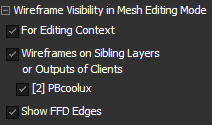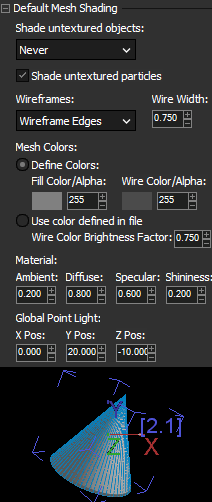Loading...
The section "Client Display" in the Global category from the Configuration tab allows to influence what is rendered in the outputs of your Client (e.g. a Server). You can for example change the rendering of the Ground Grid, Gizmo and untextured objects.
Note that all settings here are for the (remote) Client Display only. To change the rendering appearance in the (local) Preview tab, please go to the section "Preview Display" or click the according button  .
.
Gizmo Visibility for Clients "Gizmo" describes the icon with three axes in the colors red, green and blue. In the Output only Layers have a Gizmo. "Bounding Box" describes the blue box rendered around an object indicating its size. As long as you do not assign a three-dimensional object but work with flat 2D images or videos, the bounding box looks like a blue rectangle. The "Position Hint" is visible when the Preview is toggled to the Mesh Editing Mode. As you move the mouse cursor in the local Preview tab, but look at the Mesh points in the Client Display the Position Hint helps to identify where the cursor is as it renders a circle around the according position within the Client Display. |
Control Point Size on Sites |
Wireframe Visibility in Mesh Editing Mode The check box "For Editing Context" toggles the visibility of the Mesh grid (not the points itself!) for the Layer that is chosen in the "Editing Context" drop-down list, i.e. the Layer that is currently being warped and which is depicted with the editing icon in the Device Tree: The next check box "Wireframes on Sibling Layers or Outputs of Clients" toggles the Mesh grid on all other Layers and Outputs. These means that you can toggle the Mesh from the Editing Context Layer and all other ones separately. You can toggle each Site by its own which helps to align a Mesh to another one, e.g. within a softedge area where two Meshes overlap each other. The Mesh appearance, e.g. its color, can be changed in the Object Inspector. "Show FFD Edges" renders the lines between FFD points. |
Ground Grid Choose whether you want to see the Ground Grid in the Compositing and / or Output Pass which are described in the chapter Video Processing Pipeline. - Width / Height |
Mesh Shading and Color The left bottom example shows an untextured object with gray material color and blue wireframe edges. - Shade untextured object - Shade untextured particles - Wireframes - Width - Mesh Colors - Material - Global Point Light |